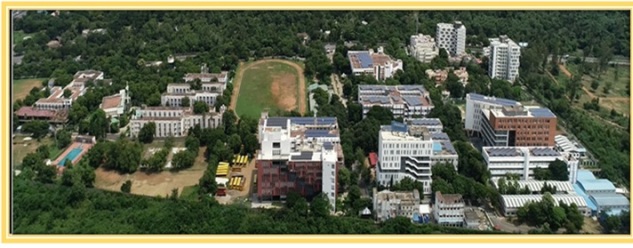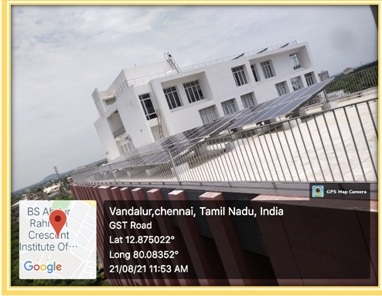Crescent Sustainability Initiatives
Affordable and Clean Energy (SDG 7)
Carbon Reduction and Emission Reduction Process
Carbon Neutrality at BSACIST: A Comprehensive Approach to Sustainable Campus Management
Benchmarking Carbon Efficiency:
Redefining Institutional Environmental Performance B. S. Abdur Rahman Crescent Institute of Science and Technology (BSACIST) has implemented a comprehensive carbon management strategy that significantly reduces its carbon footprint through innovative and sustainable practices. The institute’s total carbon emission stands at 7,369 tons per year, with a per capita carbon footprint of 1.05 tons, which is remarkably lower than the national average of 1.58 tons per capita. This represents a 33.54% reduction from the national average, demonstrating the institution’s commitment to environmental sustainability and carbon reduction.
Green Infrastructure – Strategic carbon offsetting through Ecological Interventions:
The carbon offsetting strategy at BSACIST is multifaceted, leveraging green areas and renewable energy initiatives to mitigate carbon emissions. The campus boasts 19 acres of green spaces, including tree-covered areas, lawns, and Beema Bamboo plantations, which collectively absorb 747 tons of CO2 annually. This represents 10.13% of the total carbon emissions, with the green areas covering 37.86% of the campus. The solar infrastructure plays a crucial role in this carbon reduction effort, with 650 kWp of solar photovoltaic plants installed across campus buildings, offsetting approximately 474 tons of CO2 emissions annually – equivalent to planting 21,545 trees.

Figure VII (2.3)-1 : Green Areas – 19 Acres (37.86% of the Total Campus

Figure VII (2.3)-2 :Beema Bamboo Plantations

Figure VII (2.3)-3 :Installed Roof Top Solar Power Plants
Emission Management : Integrated Technological and Operational Strategies
The institute’s carbon management approach extends beyond green spaces and solar energy. The comprehensive strategy includes multiple energy-efficient technologies and sustainable practices across various campus operations. Transportation emissions are carefully managed, with detailed tracking of petrol and diesel consumption. Electricity consumption, which accounts for the largest portion of carbon emissions (5,251,791 kg CO2), is being systematically reduced through energy-efficient technologies, including high-performance building envelopes, efficient lighting systems, and advanced HVAC technologies. The institute has also implemented water conservation measures and waste management strategies that contribute to overall carbon reduction.Innovative Technologies and Collaborative Sustainability : Beyond Traditional Approaches
Innovative technologies and collaborative approaches further enhance BSACIST’s carbon management efforts. The implementation of zero-export devices for solar power management, solar water heating systems, and energy-efficient building designs demonstrate a holistic approach to sustainability. The solar water heating systems, with a total capacity of 39,500 litres, are estimated to save approximately 24 lakhs in power consumption annually. Additionally, student-driven projects, such as solar street lighting installations, showcase the institute’s commitment to engaging the academic community in sustainable practices.Driving Sustainability: The Role of Eco-Friendly Vehicles in BSACIST’s Green Transportation Initiative
The integration of eco-friendly vehicles into the university’s transportation system highlights a practical application of BSACIST’s sustainability values, encouraging a shift toward cleaner mobility solutions while reducing overall campus emissions.Lorem ipsum dolor sit amet, consectetur adipiscing elit. Ut elit tellus, luctus nec ullamcorper mattis, pulvinar dapibus leo.
Figure VII (2.3)-4 :Eco-Friendly Conveyance @ Crescent



